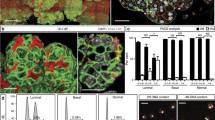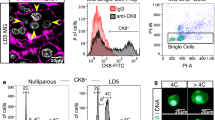Abstract
In a recent paper (Rios et al. Nat Commun. 7:11400, 2016), it was reported that polyploid cells are frequent in lactating mammary tissues. This phenomenon was observed in mammary tissue sampled from five separate mammalian species. According to that report, these binucleated cells occur late in pregnancy and early in lactation. Unfortunately, this paper did not mention a number of earlier observations and findings that remain pertinent to this day (Banerjee et al. Life sciences Pt 2: Biochemistry, general and molecular biology. 10(15):867–77, 1971; Banerjee MR, Wagner JE. Biochem. Biophys. Res. Commun. 49(2):480–7, 1972). In these classical experiments, the authors demonstrated in vivo that DNA synthesis continued without commensurate cell division during late pregnancy and lactation, and that this DNA synthesis was imperative for functional differentiation of the mammary epithelium. Later studies showed that DNA synthesis was indispensable to the induction of milk protein production in explant cultures of mammary tissue from unprimed, nulliparous mice. This dependence on DNA synthesis in mammary explant cultures stimulated by lactogenic hormones was found to be dispensable following a single pregnancy. The absolute requirement for DNA synthesis in nulliparous mouse mammary explants stimulated to synthesize milk protein in vitro has remained unexplained, as has the need for DNA synthesis prior to the onset of lactation. From a historical perspective, it is more likely that binuclear secretory cells in the lactating mammary gland are a consequence of the DNA synthesis requirement for lactation, rather than an essential element.
Similar content being viewed by others
References
Rios AC, Fu NY, Jamieson PR, Pal B, Whitehead L, Nicholas KR, et al. Essential role for a novel population of binucleated mammary epithelial cells in lactation. Nature communications. 2016;7:11400. doi:10.1038/ncomms11400.
Banerjee MR, Wagner JE, Kinder DL. DNA synthesis in the absence of cell reproduction during functional differentiation of mouse mammary gland. Life sciences Pt 2: Biochemistry, general and molecular biology. 1971;10(15):867–77.
Banerjee MR, Wagner JE. Gene amplification in mammary gland at differentiation. Biochemical and biophysical research communications. 1972;49(2):480–7.
Vonderhaar BK, Smith GH, Pauley RJ, Rosen JM, Topper YJ. Difference between mammary epithelial cells from mature virgin and primiparous mice. Cancer research. 1978;38(11 Pt 2):4059–65.
Smith GH, Vonderhaar BK. Functional differentiation in mouse mammary gland epithelium is attained through DNA synthesis, inconsequent of mitosis. Developmental biology. 1981;88(1):167–79.
Vonderhaar BK, Smith GH. Dissociation of cytological and functional differential in virgin mouse mammary gland during inhibition of DNA synthesis. Journal of cell science. 1982;53:97–114.
Smith GH. Functional differentiation of virgin mouse mammary epithelium in explant culture is dependent upon extracellular proline. Journal of cellular physiology. 1987;131(2):190–9. doi:10.1002/jcp.1041310208.
Smith GH, Medina D. A morphologically distinct candidate for an epithelial stem cell in mouse mammary gland. Journal of cell science. 1988;90(Pt 1):173–83.
Rijnkels M, Freeman-Zadrowski C, Hernandez J, Potluri V, Wang L, Li W, et al. Epigenetic modifications unlock the milk protein gene loci during mouse mammary gland development and differentiation. PLoS ONE. 2013;8(1):e53270. doi:10.1371/journal.pone.0053270.
Dos Santos CO, Dolzhenko E, Hodges E, Smith AD, Hannon GJ. An epigenetic memory of pregnancy in the mouse mammary gland. Cell reports. 2015;11(7):1102–9. doi:10.1016/j.celrep.2015.04.015.
Fantl V, Stamp G, Andrews A, Rosewell I, Dickson C. Mice lacking cyclin D1 are small and show defects in eye and mammary gland development. Genes & development. 1995;9(19):2364–72.
Fantl V, Edwards PA, Steel JH, Vonderhaar BK, Dickson C. Impaired mammary gland development in Cyl-1(−/−) mice during pregnancy and lactation is epithelial cell autonomous. Developmental biology. 1999;212(1):1–11. doi:10.1006/dbio.1999.9329.
Author information
Authors and Affiliations
Corresponding author
Rights and permissions
About this article
Cite this article
Smith, G.H. Binuclear Cells in the Lactating Mammary Gland: New Insights on an Old Concept?. J Mammary Gland Biol Neoplasia 21, 21–23 (2016). https://doi.org/10.1007/s10911-016-9356-5
Received:
Accepted:
Published:
Issue Date:
DOI: https://doi.org/10.1007/s10911-016-9356-5




